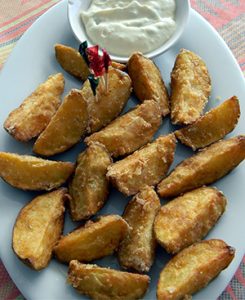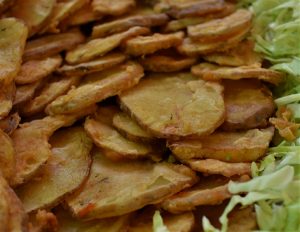The Incas survived on it. The Scots banned it on religious grounds. A French queen wore its flowers in her hair. And Peruvians today enjoy 4,000 varieties. Call it the “spud, tater” or just plain old potato (known in the science world as “Solanum tuberosum”).
Thousands of years after its emergence on the windswept highlands of South America’s Andes, the lowly potato is conquering the world. “The potato is continuing its march,” said an official of the Peruvian-based International Potato Center. “There’s just something about potatoes that everyone likes. It goes with anything.”
The potato was domesticated in southern Peru and northern Bolivia. In pre-Colombian times, potatoes were also widely cultivated on Chiloe Island in Chile. Potatoes spread from South America to Spain and from there to the rest of the world after European colonization in the late 1400s and early 1500s.
Potatoes soon became an important field crop. Today, potatoes are the world’s most widely grown tuber crop. They are also the fourth largest food crop in terms of fresh produce — after rice, wheat and corn.
In Quechua language, the word for potato is “papa.” The English word “potato” comes from Spanish “batata,” which actually refers to sweet potato (“Ipomoea batatas”). Sweet potato was introduced in Europe much earlier — brought from the Caribbean by Christopher Columbus himself. Though a different plant, in both plants their underground parts are eaten, which led to confusion.
Currently, there are about five thousand potato varieties around the world. Three thousand of them are found in the Andes alone, mainly in Peru, Bolivia, Ecuador and Colombia. They belong to eight or nine species. Apart from the five thousand cultivated varieties, there are about 200 wild species, many of which can be cross-bred with cultivated species, which has been done repeatedly to transfer resistances to certain pests and diseases from the genepool of wild to the genepool of cultivated potato species.
Although the Spanish most likely brought the potato to the Philippines, the precise date or circumstances of the introduction is unknown. History records showed that the first mention of the potato in the Philippines was made by the Jesuit naturalist, George Joseph Camel, who lived in the Archipelago in the late 18th Century. The term “papa” was recorded by him as the word used by Filipinos and Spaniards to designate the crop.
Although potato was first introduced in the Philippines in Cebu, it was not until in the 1920’s when the crop was brought to the highlands of Luzon, particularly Mountain Province, that potato was given importance. By the late 1930’s it was being produced in greater quantities. The demand for potatoes increased significantly with the continuing presence of American in Baguio, Manila, and the military bases.
 Among Filipinos, potato is consumed as a vegetable and occasionally as a snack item. It is ideally cooked with meat, often as a meat extender in recipes such as adobo, egado, curry, and lumpia. A large amount of potato is consumed in the country by people who are wealthy, professionals, potato wholesalers and retailers, and those who have had extended contact with potato-eating cultures. The urban poor and rural people living at a distance from potato production zones consume the least amount of potato due to their relative seasonal availability and high cost.
Among Filipinos, potato is consumed as a vegetable and occasionally as a snack item. It is ideally cooked with meat, often as a meat extender in recipes such as adobo, egado, curry, and lumpia. A large amount of potato is consumed in the country by people who are wealthy, professionals, potato wholesalers and retailers, and those who have had extended contact with potato-eating cultures. The urban poor and rural people living at a distance from potato production zones consume the least amount of potato due to their relative seasonal availability and high cost.
Traditionally, potato is grown in the highlands, where the temperature is cool. Production of potato in the lowlands is still negligible. Researchers said a yield of 50 tons and 35 tons per hectare in the highlands and lowlands, respectively, can be attained if quality seeds and other necessary inputs are provided.
More than 90 per cent of the production of potatoes takes place in the highland areas of Northern Luzon (Benguet and Mountain Province) followed by upland production areas of Bukidnon province of Mindanao (particularly around Mt. Kitanglad in the areas of Kubayan, Intavas, Kibinton, Impasugong, Dalwanga and Lantapan). Scattered but very limited production is found in the mountainous areas of the Visayas.
 “A potato crop produces more edible energy and protein per hectare and per unit of time than practically any other crop,” says the Laguna-based Philippine Council for Agriculture, Forestry and Natural Resources Research and Development (PCARRD).
“A potato crop produces more edible energy and protein per hectare and per unit of time than practically any other crop,” says the Laguna-based Philippine Council for Agriculture, Forestry and Natural Resources Research and Development (PCARRD).
The PCARRD, in a publication entitled, “The Philippines Recommends for Potato,” shares some timely tips on growing the crops:
1. For optimum yields, a deep well-drained loam or sandy loam soil with a pH of 5.5-6.0 is required. Fertile soil rich in organic matter is essential for good growth.
2. Pre-sprouted tubers with sprouts 2-3 centimeters long are recommended for planting. About 1.5-2.5 metric tons of seed pieces are needed per hectare.
3. Plow the field at least twice (23-30 centimeters deep) and harrow it once after each plowing. Weeds and infected plant debris should be removed and piled or buried in a place outside the field.
4. The best time to plant is at the onset of the cool months. Either the double or single row system of planting may be used depending on the terrain.
5. Potatoes require adequate fertilization for high yields. It is advisable that farmers have their soils analyzed first before planting in order to know how much and what fertilizers to apply and whether the application of lime is necessary.
6. Potatoes cannot tolerate excessive rainfall or soil moisture. Good drainage is highly desirable to allow the moisture level to remain at an optimum particularly when the crop is about to be harvested.
7. Control pests and diseases. Both do not only reduce yield but also lower the quality of the tubers. Proper identification is necessary before realistic control measures can be taken.
Potatoes mature in 70-120 days from seed tuber planting to harvesting. At harvest time, about 70-75 percent of the foliage has naturally turned pale yellow or become dry. The PCARRD publication informs: “The vines should be cut, pulled or killed with paraquat a week before harvesting to harden the tubers. The best time to harvest is when the weather is cool and less humid. These conditions will prevent cracking and heat injury to the tubers. Immediately after harvesting, allow the tubers to stand on top of the soil for 15-60 minutes depending on the temperature, to toughen the skin.”







